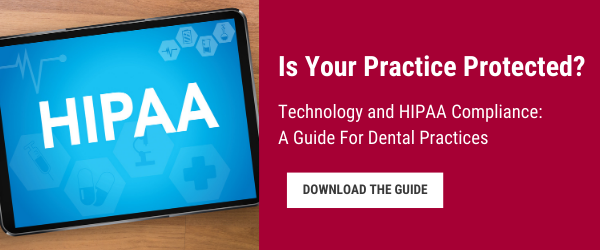
By: Michael Vincelette on April 12th, 2021
Email Encryption for Securing Your Dental Practice
Many dental practices communicate with patients via email— from appointment reminders or billing to friendly newsletters. It’s the nature of the digital age!
But convenient digital communication comes with a long list of security concerns, from office-wide malware infection to patient data leaks. With all its risks, email communication is not something dental practices should use lightly.
One way to better protect your email is to encrypt your messages. But for dental practitioners, cybersecurity is admittedly not their specialty— and the word ‘“encrypt” might as well be from another language.
In this article, we’ll talk about what email encryption involves and consider how the right solution could better safeguard your practice from cyber attacks and compliance violations.
What is Email Encryption & How Does it Work?
Email encryption is a method for securing email communications between the sender and the recipient. It’s an electronic way of keeping peeping eyes away from privately exchanged messages.
Email encryption comes in two forms: transport layer security (TLS) and end-to-end encryption.
Most standard email providers like Microsoft and Google traditionally use TLS, which helps to protect your mail while it’s in digital transit. From the moment your email leaves your inbox throughout its entire cyber journey to the recipient’s inbox, it stops your email from being read. This prevents the contents of the email from what’s known as a “man-in-the-middle” compromise.
While this type of email encryption has its merits, it only safeguards the email when it’s on the move. Once it lands in an inbox, it’s easy for a hacker who breaks into your email account to peruse your “sent” and “received” messages. Or, the hacker could access the recipient’s system, whether it’s another practice’s or a patient’s.
To add another layer of protection, many email providers also use a second form of email protection called end-to-end encryption, which works by means of “keys.” One public key encrypts your message on its way out the digital door. It can only be decrypted by another private key (one that you shared with the recipient) End-to-end encryption ensures only the intended recipient can decrypt your message. Another way to set up secure access to encrypted email is to have it sent to a secure server. The recipient then has to log in to the server to retrieve the message.
Why is Email Encryption Important for My Practice?
As a dental practice owner, you know how much personally identifiable information (PII) you deal with on a daily basis. You also know there are HIPAA compliance requirements in place to protect the privacy of said information.
Did you know that HIPAA requires that any email containing ePHI (electronic Protected Health Information) sent outside of your internal email network be encrypted?
That means that when you discuss any information about a patient record— including but not limited to medical conditions, medications, radiographic images, and lab test results— over email, you must encrypt it to avoid costly violations or patient data exposure.
Why Transport Layer Security (TLS) is Not Enough
While most email providers today automatically offer the first form of encrypted email protection, TLS, this encryption only protects your email contents during its movement from your inbox and server to the recipient’s.
For additional protection, practices can pay for end-to-end encryption services from a specific provider. Encryption service companies handle the “key” management we discussed above. Oftentimes, these easy plug-in service providers allow you to encrypt your email with the click of an “encrypt” button. It’s really that easy! And it’s just as easy for the receiver to decrypt it with one extra click.
Other Ways to Make Your Emails HIPAA Compliant
While integrating encryption functionality into your current email service is an excellent way to protect the PII or PHI in your digital messages, it’s not your end-all-be-all solution for staying HIPAA compliant.
You’ll also want to:
- Lock into a HIPAA-compliant Business Associate Agreement with your email provider
- Develop policies around the proper use of email and educate your staff
- Make sure all emails are retained for six years (that’s right— even longer than taxes!)
- Get written consent from patients before communicating with them via email
- And more!
Discover all the ways to make your email HIPAA compliant here.
Are You Meeting All Compliance Protocols?
Email security is a crucial element of your dental office’s PII or PHI protection, but it’s certainly not the only thing to consider when it comes to HIPAA regulations for your practice.
Request a consultation with our team to run a compliance overview, just for you, to assess your current standing against HIPAA protocol.



